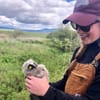Climate change is changing public health
In Washington, a new team of epidemiologists is preparing for a hotter, smokier future.

Eight years ago, the only worker explicitly focused on the intersection of climate change and public health at the Washington Department of Health was an intern. Since then, the 2021 Pacific Northwest heat wave caused at least 100 heat-related deaths in Washington along with a massive spike in emergency department visits. University of Washington researchers estimated that roughly 200 residents died from wildfire smoke in September 2020 alone, and noted that exposure to smoke exacerbates asthma and lung diseases. Now, Washington’s Environmental Public Health Division has three climate-focused epidemiologists — two of them hired in the last year — who investigate patterns and causes of disease to anticipate, cope with and prevent them.
The Department of Health’s expanding climate health team, which also includes a scientist who studies insects as disease vectors and experts on water quality and climate justice, is part of a deepening understanding of how profoundly climate change affects human health. Recent studies paint a grim picture: In addition to increasing the severity and frequency of both extreme heat events and wildfires, climate change is creating disease hotspots while also making some infectious diseases worse. This realization is changing health experts’ training, including at Harvard Medical School, which recently added a climate curriculum to all four years of instruction.
The Washington climate team members approach their work with the foundational understanding that climate exacerbates historic injustices. “Communities of color, children, older adults and pregnant people are all more sensitive to the impacts of climate change,” said Kelly Naismith, the agency’s newest climate epidemiologist. “They’re more vulnerable.” She plans to monitor emergency room data in close to real time to see how high temperatures drive diagnoses and patient numbers. “One thing we’ve learned in the past couple years, during heat waves, is that there’s a pretty big increase in ER visits,” she said.
Michelle Fredrickson is quantifying the unequal distribution of climate impacts. She’s using LiDAR, or Light Detection and Ranging, a type of laser scan, to determine how tree canopy, green space and asphalt coverage affect neighborhood temperatures during heat waves. Her work builds on research that has already shown how widespread those inequities are. A nationwide study published in 2020 found that areas subject to racist housing practices in the 1930s experience hotter temperatures today: Lower-income people and people of color live in areas with less greenery and more asphalt, which magnifies heat.
Washington epidemiologists are using existing data about air quality and heat-related deaths, things that are historically monitored by public health departments, for a new purpose: illuminating their connections to climate change. “When you start pulling together climate data and environmental hazard data, it starts to paint a clearer picture of the existing environmental justice issues in the state,” said Rad Cunningham, senior epidemiologist. “You start seeing patterns of how those issues are going to get worse over time.”
But they’re not just addressing current issues; they’re also trying to determine what the future will look like and how to prepare for it. “It’s a paradigm shift,” Cunningham said. A proactive approach can help states save lives, blunt unhealthy trends and be better prepared for emerging climate-driven threats.
That may improve the situation on the ground in Washington in the coming years. School evaluations could show where state funding is most needed to retrofit buildings and design new ones to make spaces cooler and cleaner on hot, smoky days. The team is working to make public health tools and messaging — such as tips on how to protect yourself from wildfire smoke with box fans and filters — less jargony and more useful. The epidemiologists are collaborating with newly created, climate-focused local public health positions across the state.
The climate health team’s total budget — $1.8 million this fiscal year — comes from state and federal sources. Washington is looking to climate health programs in other states like California and Colorado for inspiration. And the epidemiologists hope to learn from places dealing with problems that aren’t as prevalent in Washington — yet. For example, warmer temperatures are allowing ticks to spread into areas they previously weren’t able to survive. In response, Michigan’s Department of Health has become an expert on ticks and tick-borne diseases, such as Lyme. “We have a lot to learn from them,” Cunningham said. “We have a chance to do what they wish they would’ve done.”
Kylie Mohr is an editorial fellow for High Country News writing from Montana.
The story you just read is only possible because readers like you support our mission to uncover truths that matter. If you value this reporting, help us continue producing high-impact investigations that drive real-world change. Your donation today ensures we can keep asking tough questions and bringing critical issues to light. Join us — because fearless, independent journalism depends on you!
— Jacob H. Fries, executive director
DonateCancel anytime.








